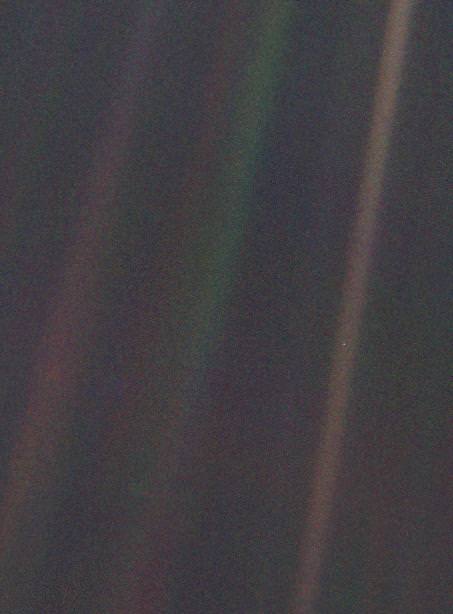Thirty years have now passed since the Voyager 1 spacecraft snapped one of the most iconic and memorable pictures in spaceflight history. Known as the "Pale Blue Dot," the heart-rending view shows planet Earth as a single, bright blue pixel in the vastness of space, as seen from the outer reaches of the solar system.
Now, NASA and the Jet Propulsion Laboratory have provided a new and improved version, using state of the art image-processing software and techniques to reprocess the thirty-year-old image. JPL software engineer and image processor Kevin Gill, whose images we feature often on Universe Today, led the effort.
"I'm very happy with how it came out and proud to be able to share it," Gill said. "I was incredibly honored to get to work on these historic images."
The original image was obtained on Feb. 14, 1990. Rays of sunlight scattered within the camera optics stretch across the scene, and one ray dramatically intersects with Earth, making it appear as a "mote of dust," as astronomer Carl Sagan phrased it. Sagan was a member of the Voyager imaging team at the time and had the idea for pointing the spacecraft back to look back toward home for a final time. Voyager 1's camera snapped a series of 60 images that were used to create the first "family portrait" of our solar system.
Making the image even more poignant is that it was taken just minutes before Voyager 1's cameras were intentionally powered down to conserve power. NASA also knew that both Voyager 1 and 2 would not make close flybys of any other objects during their remaining lifetimes. Shutting down instruments and other systems on the two Voyager spacecraft has been a gradual and ongoing process that has helped enable their longevity.
For the newly reprocessed image, Gill said he consulted with planetary scientist Candy Hansen and engineer William Kosmann, who both helped process the original image. Gill processed the images from the raw data rather than starting with the already published one.
"I don't know how they processed the original images," Gill told Universe Today, "but I used a pipeline that includes custom software, USGS ISIS3, Photoshop, and Lightroom. I also handled the color differently than the original. The mission planners took the photo in green, blue, and violet light so it's false color, but I applied a white balancing on the main sunbeam and retained a lot of the ambient light which made smoothing easier."
He added that preventing graininess and allowing large upscaling were goals for the reprocessing.
At the time the original photo was taken, Voyager 1 was speeding out of the solar system — beyond Neptune and about 3.7 billion miles (6 billion kilometers) from the Sun.
"That's here. That's home. That's us," Sagan wrote in his book, 'Pale Blue Dot.' "On it everyone you love, everyone you know, everyone you ever heard of, every human being who ever was, lived out their lives. … There is perhaps no better demonstration of the folly of human conceits than this distant image of our tiny world."
Voyager 1 has been traveling over 42 years since its launch in September of 1977, and is now nearly four times as distant from Earth as it was in 1990, when it took the 'Pale Blue Dot' image.
Read JPL's press release for more information on the new image. See this NASA page for more information about the 'family portrait' of the Solar System.
 Universe Today
Universe Today


